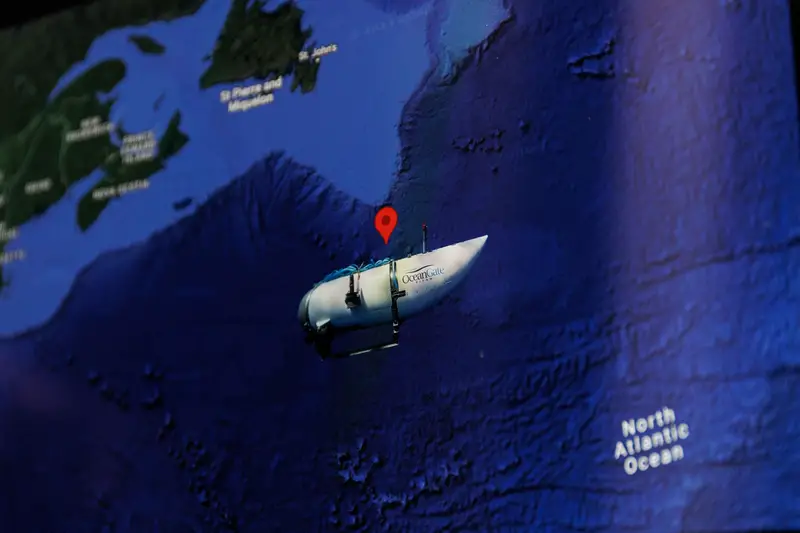When the OceanGate Titan submersible imploded in June 2023 during its trip to see the Titanic wreck, everyone expected total destruction. The extreme pressure at 12,500 feet below the ocean surface can crush almost anything in seconds. But Coast Guard investigators found something incredible when they recovered the wreckage – several everyday items survived completely intact while the titanium and carbon fiber submarine was destroyed.
A simple pen survived when the submarine didn’t
The most shocking discovery was an ink pen found inside CEO Stockton Rush’s sleeve that was completely undamaged. Coast Guard Lieutenant Kelly Steele couldn’t believe what she was seeing when she examined the debris. The pen worked perfectly, with no cracks or breaks, even though it had been through forces that completely destroyed a multi-million dollar submarine. Think about that for a second – your average ballpoint pen that costs maybe a dollar survived something that obliterated titanium walls.
What makes this even more amazing is that investigators found the pen buried in sand and debris that had turned into sludge. Everything around it was completely destroyed – carbon fiber pieces, electronic parts, and metal components were all shattered beyond recognition. Yet somehow this simple writing tool remained intact inside Rush’s clothing. The sleeve piece was described as being “caked inside of sand,” but when investigators carefully cleaned it out, there was the pen, ready to write.
Business cards made it through the disaster
Even more surprising than the pen were the business cards that survived inside Rush’s sleeve. Paper products aren’t exactly known for being tough, especially when they’re exposed to crushing ocean pressure and violent forces. These cards were found alongside the pen, still readable and in good condition. Most people wouldn’t expect their business cards to survive getting wet in the rain, let alone a catastrophic submarine implosion two and a half miles underwater.
The survival of paper items particularly amazed the Coast Guard recovery team. They had been sifting through what they described as “sludge-like remains” for weeks, finding mostly unrecognizable debris. When they discovered these business cards, still legible after being subjected to unimaginable forces, it highlighted just how unpredictable deep-sea disasters can be. Sometimes the most fragile items survive while the strongest materials fail completely.
Titanic stickers stayed stuck despite everything
Along with the pen and business cards, investigators found Titanic-themed stickers that were still intact. These weren’t just surviving – they were in pristine condition, as if they had just been printed. The stickers were probably souvenirs or promotional materials related to the submarine’s mission to visit the famous shipwreck. What’s incredible is that these tiny pieces of adhesive paper withstood pressures that would instantly crush a car.
The stickers represent something almost poetic about the tragedy. Here were these small reminders of the Titanic, itself a famous maritime disaster, surviving another ocean catastrophe over a century later. Coast Guard officials noted that finding these delicate items was like discovering treasure among the wreckage. They had expected to find only metal fragments and electronic components, not perfectly preserved paper souvenirs.
The endcap acted like a protective bowl
Coast Guard experts explained that the submarine’s “endcap” – a rounded piece at one end of the vessel – functioned like a mixing bowl during the implosion. This created a protective space where items could become “encased inside” rather than being scattered or destroyed. The endcap’s shape helped shield certain debris from the worst of the crushing forces. It’s similar to how sometimes the eye of a hurricane can be calm while destruction swirls around it.
This protective effect explains why Rush’s sleeve and everything inside it survived relatively intact. The clothing acted as an additional barrier, wrapping around the pen, cards, and stickers like a natural protective case. When the submarine imploded, these items were essentially cushioned by multiple layers of protection – the endcap structure and the fabric of the clothing. This combination created a small safe zone in the middle of an otherwise catastrophic event.
Clothing pieces protected what was inside
The fact that part of Rush’s sleeve survived was remarkable enough, but what it contained was even more extraordinary. The fabric had somehow maintained its integrity during the implosion, creating a pocket that preserved its contents. Most of the clothing recovered from the wreckage was in fragments or completely destroyed, making this sleeve piece an anomaly among the debris.
Investigators described finding the sleeve “caked inside of sand,” which actually helped preserve it further. The sand acted like a natural protective coating, similar to how volcanic ash can preserve archaeological artifacts. When they carefully cleaned away the sediment, they revealed not just the fabric but also the perfectly preserved items tucked inside. This shows how sometimes the most unexpected combinations of materials and circumstances can create protection in disaster situations.
Recovery teams found mostly sludge and debris
The contrast between the surviving items and the rest of the wreckage was stark. Most of what the Coast Guard recovered looked nothing like the original submarine parts. The debris had been transformed into an unrecognizable mixture of carbon fiber fragments, twisted metal pieces, and electronic components all mixed together with sand and seawater. Recovery teams described the process as sifting through sludge, trying to identify anything that might provide clues about what happened.
This makes the survival of the pen, cards, and stickers even more remarkable. While sophisticated submarine components worth millions of dollars were reduced to unidentifiable fragments, these simple everyday items remained perfect. The recovery operation took weeks of careful work, with investigators cataloging every piece they found. Finding intact items among all that destruction was like finding needles in a haystack, except these needles were completely undamaged.
The submarine was built to handle extreme pressure
The OceanGate Titan was constructed with cutting-edge materials specifically chosen for deep-sea exploration. Its hull combined carbon fiber and titanium, materials that are incredibly strong under normal circumstances. The submarine was designed to protect passengers from the crushing pressure found at the depth of the Titanic wreck, which is over 380 times greater than the pressure we experience at sea level. Engineers spent years developing and testing these materials for this exact purpose.
Yet despite all this advanced engineering and expensive materials, the submarine failed catastrophically while a simple pen succeeded. This highlights how unpredictable extreme situations can be. The same forces that turned titanium and carbon fiber into fragments somehow left a plastic and metal pen completely unharmed. It’s a reminder that sometimes the simplest designs are the most resilient, even when faced with forces beyond imagination.
Deep sea pressure creates unpredictable results
The pressure at 12,500 feet below the ocean surface is difficult for most people to comprehend. It’s equivalent to having a large elephant standing on every square inch of surface area. When a submarine implodes at this depth, the water rushes in faster than the human eye can see, creating forces that can instantly destroy almost anything. The temperature and pressure changes happen so quickly that predicting what will survive is nearly impossible.
This explains why investigators were so surprised by their findings. Even experts who understand deep-sea physics couldn’t have predicted that paper items would survive while metal components were destroyed. The chaotic nature of an implosion creates pockets of protection in some areas while completely obliterating others. What survived from the Titan submersible shows just how random and unpredictable these extreme events can be, defying logical expectations about material strength.
These items now serve as important evidence
The surviving items aren’t just curiosities – they’re crucial pieces of evidence for the ongoing investigation into what caused the implosion. The Marine Board of Investigation has carefully cataloged every recovered artifact, including the pen, business cards, and stickers. These items help investigators understand the sequence of events during the disaster and provide clues about the submarine’s final moments. Even something as simple as where the pen was found can tell experts important details about the implosion.
The condition of these items also helps scientists better understand how materials behave under extreme pressure. This knowledge could potentially improve safety designs for future deep-sea vehicles. Every piece of evidence, no matter how small or seemingly insignificant, contributes to a better understanding of what went wrong. The fact that these everyday items survived gives investigators additional data points to work with as they piece together the complete picture of the tragedy.
The survival of these ordinary items from the OceanGate Titan implosion shows how unpredictable extreme disasters can be. While advanced materials failed, simple everyday objects endured forces that most people can’t even imagine. These findings remind us that sometimes the most unexpected things survive when everything else falls apart.

